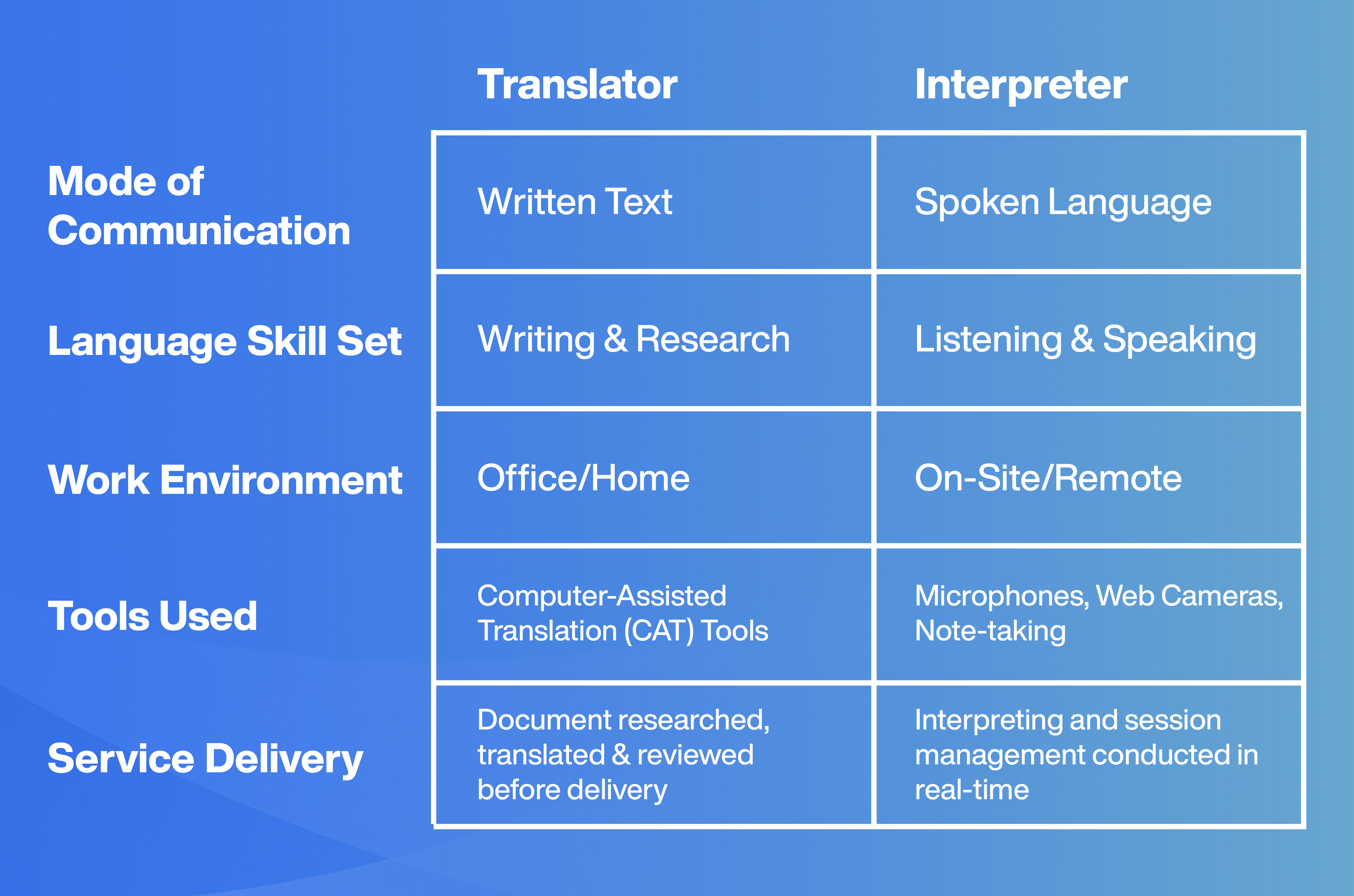When it comes to breaking down language barriers, translators and interpreters are invaluable. But what exactly is the difference between a translator and an interpreter? In short, translators work with written content, while interpreters handle spoken communication. However, there’s much more to understand. Continue reading to learn the differences between interpreters vs. translators, why these differences matter, and how to ensure you choose the right service for your needs.
Learning the Difference Between Translation vs. Interpretation
Translators and interpreters may work with languages, but they are recognized as separate professions with different roles and skill sets. Translators focus on written language, converting text from one language to another. Interpreters, however, work with spoken language, facilitating real-time communication between speakers of different languages. Despite their distinct roles, both are essential in helping people communicate across language barriers.
What is a Translator?
A translator is a language professional who converts written text from one language into another. A translator’s goal is to ensure that the original text’s meaning, tone, and context are preserved in the translation. Translators often work with several types of documents, including legal, technical, and literary texts. Their work requires a deep understanding of the source and target languages, cultural nuances, and writing conventions.
What is an Interpreter?
An interpreter is a language professional who converts spoken words from one language to another in real-time. They facilitate smooth and accurate communication between speakers of different languages. Interpreters work in courtrooms, conferences, hospitals, and live events, where their ability to think quickly and communicate effectively is crucial.
Need a Professional Interpreter? Ensure clear and accurate communication for your next event or meeting. Explore Boostlingo’s interpreters page to find the right professional for your needs.

Why Understanding the Difference Matters
Imagine you’re planning an international conference where speakers from various countries will present their research. You’ve prepared all the necessary document translation in multiple languages and assume your job is done. But on the day of the event, you realize there’s a critical gap: the audience can’t follow along because they speak different languages. In this scenario, a translator’s expertise in written text won’t suffice. What you need is an interpreter—a linguistic expert who can think on their feet, processing and delivering spoken content in real-time, allowing all attendees, regardless of language, to engage fully and understand.
Understanding the difference between translators and interpreters is essential for businesses, legal professionals, healthcare providers, and individuals. Interpreters must have mental and linguistic flexibility, juggling complex ideas and languages in the moment, while translators focus on ensuring accuracy and nuance in written content. Each role requires a unique skill set, and choosing the wrong service could lead to miscommunication or legal issues. Misunderstandings about these roles can lead to hiring mistakes, so knowing exactly what you need is critical.
What Does a Translator Do?
Translators convert written content from one language to another. They work with any kind of documents, such as legal contracts, technical manuals, websites, and literary works. Their job is to ensure that the translated text accurately reflects the original meaning, style, and tone while also being culturally appropriate for the target audience.
Translator Required Skills and Qualifications
Translators must be highly proficient in both the source and target languages. They also need strong writing skills and cultural knowledge to produce accurate and nuanced translations. Many translators hold certifications or have undergone specialized training to demonstrate their expertise.
Tools and Technology Used by Translators
Translators often use computer-assisted translation (CAT) tools and other software to enhance efficiency and accuracy. These tools can help manage large projects, ensure consistency in terminology, and improve overall translation quality. While machine translation has advanced, human translators remain crucial for delivering accurate, contextually appropriate translations.
What Does an Interpreter Do?
Role and Responsibilities of an Interpreter
Interpreters facilitate spoken communication between speakers of different languages. They work in real-time, ensuring conversations flow smoothly without language barriers. Interpreters work anywhere multilingual communication is needed, such as in courtrooms, medical settings, conferences, and live events, where their ability to convey meaning accurately and quickly is critical.
Interpreter Required Skills and Qualifications
Interpreters also need to be highly proficient in the languages they work with and possess excellent listening and speaking skills. They must be quick thinkers, able to process and translate spoken words instantly. Like translators, interpreters often hold certifications and have undergone rigorous training to ensure they meet professional standards.
Learn more about consecutive notetaking and how you can improve interpretation accuracy.
Types of Interpretation
There are several techniques used in interpretation, each suited to different scenarios. Simultaneous interpretation involves interpreting spoken language at the same time as the speaker and is often used in conferences and live events. Consecutive interpretation, where the speaker pauses so the interpreter can speak, is most common in medical, legal, and educational settings. Sight translation is when the interpreter reads what is written in a document out loud into the other language. It combines reading and interpreting. Whispered interpretation is a type of simultaneous interpretation delivered without equipment directly to one or two individuals.
Discover more about how interpreting services are delivered, including Video Remote Interpreting (VRI), Audio Interpreting, Event Interpreting, Sign Language, and Telehealth.
Key Differences Between Translators and Interpreters
Mode of Communication
The most significant difference between translators and interpreters is their mode of communication. Translators work with written text, while interpreters work with spoken language. This distinction influences their work environments, tools, and the skill sets they need.
Work Environment
Translators typically work in offices or from home, often collaborating with clients or teams remotely. They can take their time to ensure accuracy and polish in their work. Interpreters usually work on-site or remotely via phone or video, providing real-time interpretation services in various settings, from courtrooms to hospitals.
Required Skill Sets
Translators need to be detail-oriented and have strong research and writing skills. They must ensure that every word accurately reflects the original text while considering cultural nuances. On the other hand, interpreters need to be quick on their feet, have excellent listening, speaking skills, and problem-solving skills. They must make fast decisions and communicate clearly under pressure—managing barriers to communication when they arise.
How to Choose Between a Translator and an Interpreter
Choosing between a translator and an interpreter depends on the type of communication needed and the specific requirements of your industry. If you need written documents translated, a translator is the right choice. An interpreter is essential for spoken communication, whether for live events, meetings, or medical appointments. Consider the context and the nature of the communication to determine which service is appropriate.
Ensuring Clear Communication Across Languages
Clear communication across languages is crucial, especially in scenarios like the international conference example mentioned earlier. Imagine the confusion and missed opportunities if you hired a translator to prepare written materials but didn’t arrange for an interpreter to facilitate live discussions. Such a mistake could leave your audience lost, unable to follow the presentations or engage meaningfully with the content.
Understanding the distinct roles of translators and interpreters helps prevent these kinds of miscommunications. Whether you need written documents translated for clarity or real-time interpretation to ensure all participants can fully engage, choosing the right professional is key. At Boostlingo, we offer a range of translation and interpreter services tailored to meet your specific needs, helping you avoid the pitfalls of miscommunication, ensuring that your message is understood by everyone, no matter the language.



